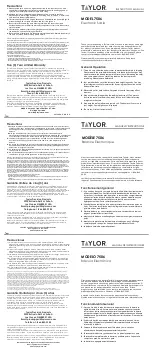
CHAPTER 4 TESTING
4.1 TESTING
Before and after servicing a Defender Base, conduct Load Cell Resistance Checks, Calibration
using an external Indicator, and Performance Tests to confirm that the base meets
specifications. Allow time for the base to stabilize after moving it from an area which is at a
different temperature than the area where it is to be operated. Allow one hour for each 5°F
(2.7°C) temperature change before using the base.
The following tests require a Digital Multimeter, an Indicator and hand tools. The Digital DC
Voltmeter should have a reading range from 1 mV to 50 V full-scale. It should be capable of
reading differences of one micro-volt per increment. The indicator can be either the Ohaus
Defender 3000, or an equivalent commercial indicator.
NOTE:
Make sure the test area is free from drafts and that the base rests on a level and
vibration-free surface.
4.2 Load Cell Resistance Checks
Use an ohm-meter to measure across each pair of wires, and compare the results with
Table 4-1. The Load Cell must be completely disconnected from the Indicator and at no load
when these tests are made.
In addition to the four resistance elements which make up the Wheatstone Bridge, there are
commonly one or two resistors in the excitation lines. The resistance across the excitation wires
is usually the highest resistance measured across any two wires.
If the resistance readings are in the range specified, skip to the next section. If they are
incorrect – for example, outside the expected range, open circuit or short-circuit across any two
wires – the likely causes are a damaged or faulty Load Cell or incorrect or faulty wiring. If the
Load Cell is defective, replace it. (See Chapter 3.)
TABLE 4-1. LOAD CELL RESISTANCE READINGS (in Ohms)
Models
Ex+ to Ex
–
S+ to S
–
Ex+ to S
–
Ex+ to S+
Ex
–
to S+
Ex
–
to S
–
B Series
410 ± 10
350 ± 4
313 ± 10
313 ± 10
262.5 ± 10 262.5 ± 10
V Series
387 ± 10
350 ± 4
297 ± 10
297 ± 10
262.5 ± 10 262.5 ± 10
4.3 Calibration with an External Indicator
1. Install the Load Cell in position. (See Section 3.2.)
2. Connect the excitation, signal shield and sensing wires (if provided), to the Indicator.
Calibrate the Indicator to read the load in the units required, for example, kilograms or
grams. (Consult the Indicator instruction manual for calibration procedures.) For
calibration mass weights, see Table 1-1, in Chapter 1.
3. Check that the Indicator is reading correctly over a range of values.
Defender™ B & V Series Service Manual
4-1
Ohaus Corporation www.ohaus.com
Summary of Contents for Defender D30BR
Page 2: ......
Page 4: ......
Page 12: ...CHAPTER 1 INTRODUCTION Ohaus Corporation www ohaus com 1 6 Defender B V Series Service Manual...
Page 24: ...CHAPTER 4 TESTING Ohaus Corporation www ohaus com 4 6 Defender B V Series Service Manual...
Page 30: ...APPENDIX A GLOSSARY Ohaus Corporation www ohaus com A 2 Defender B V Series Service Manual...
Page 31: ......
Page 32: ...80252594 P N 80252594 A SERVICE MANUAL DEFENDER B V SERIES BASES...














































